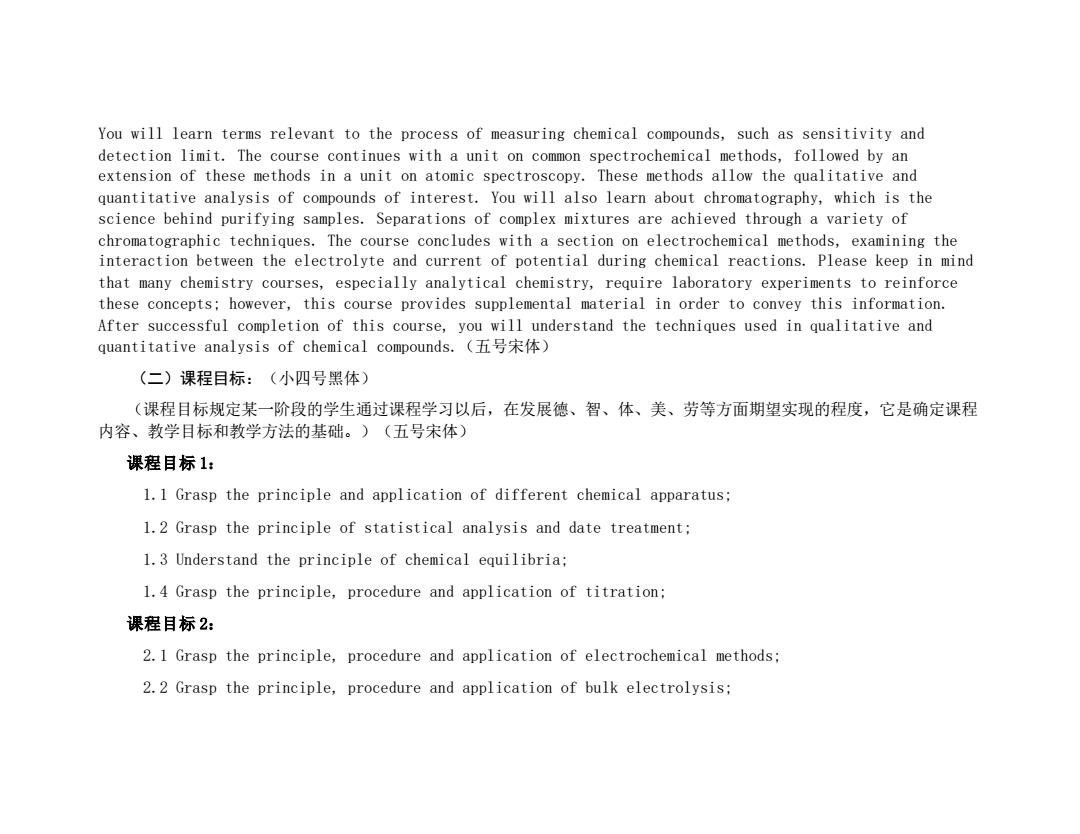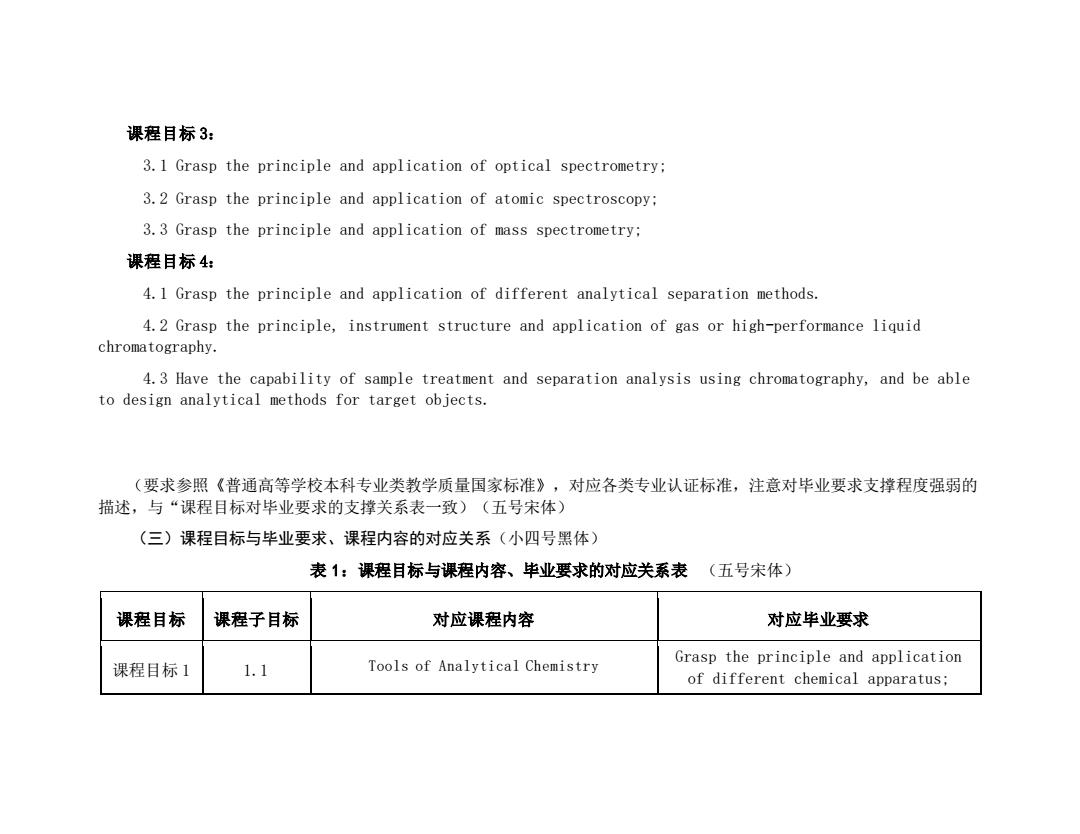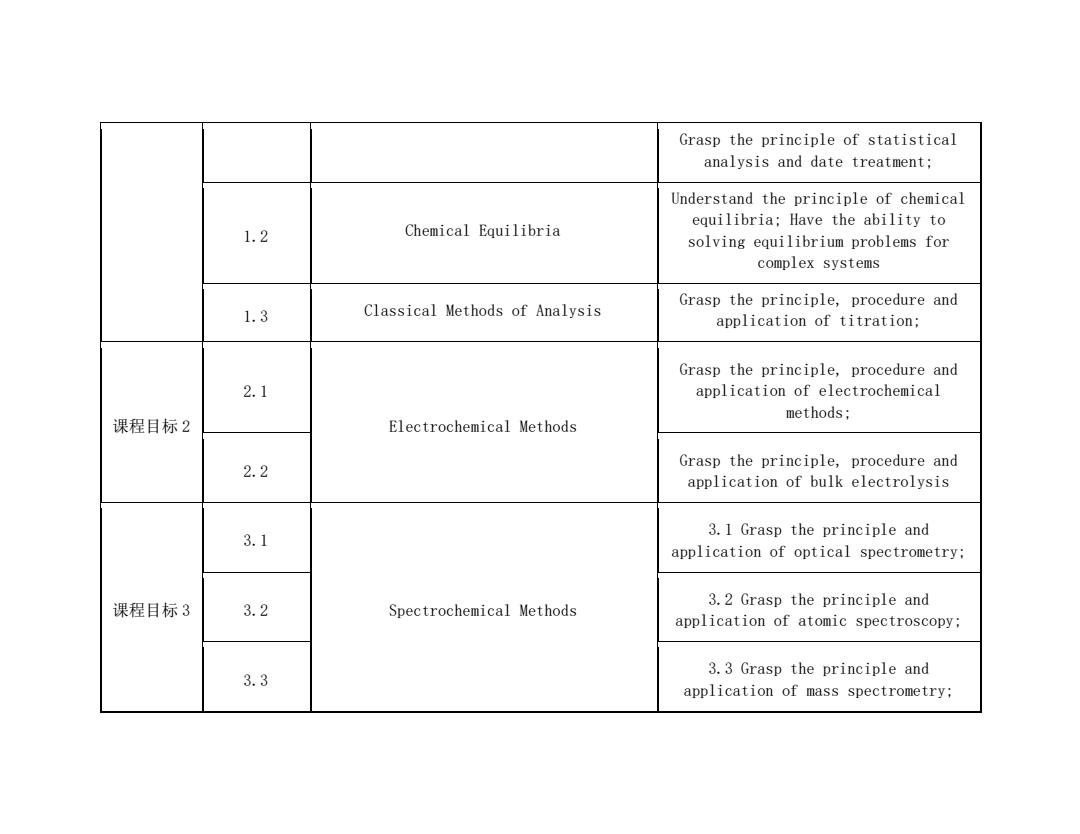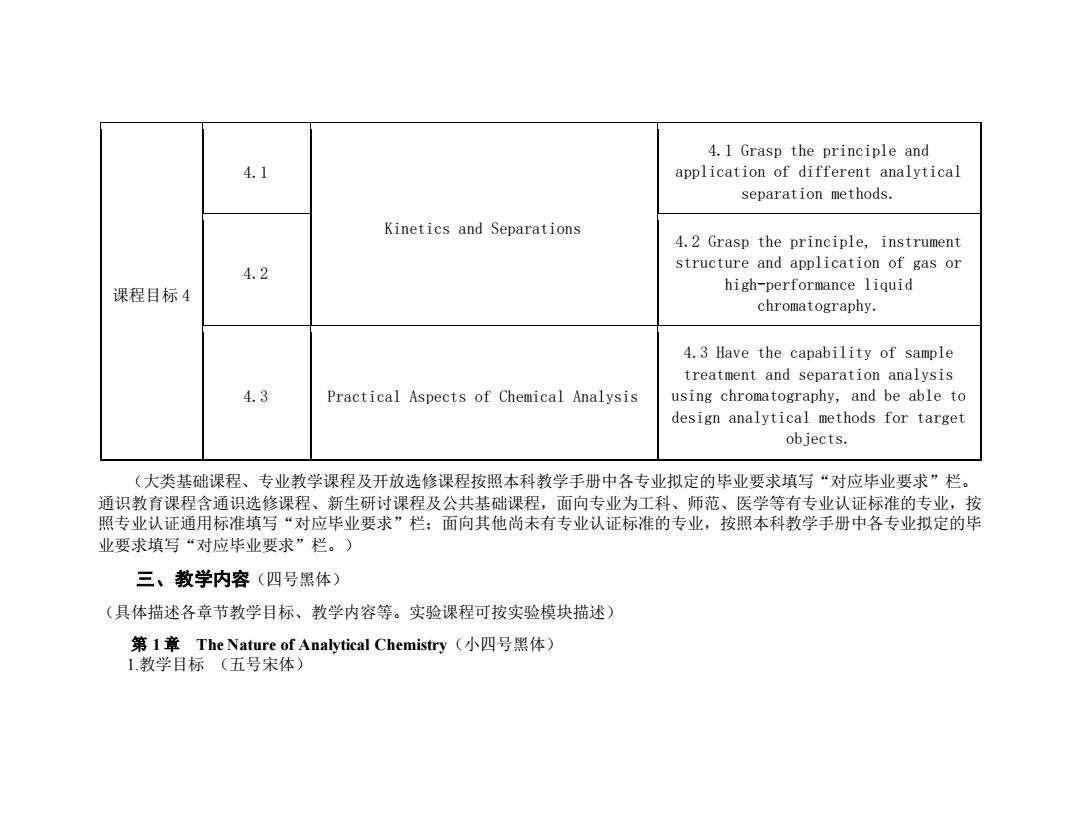
《Analytical Chemistry》课程教学大纲 一、课程基本信息 英文名称 Analytical Chemistry 课程代码 PHAR1117 课程性质 Basic Courses 授课对象 Pharmacy 学 分 7.5 学 时 162 主讲教师 Weipeng Wang,Duxin Li,Chunshan Gui,Jianqing Ruan,et al. 修订日期 2021.6.20 指定教材 Fundamentals of Analytical Chemistry (International Edition),by Douglas Skoog Stanley Crouch,Cengage Learning,2013 二、课程目标(四号黑体) (一)总体目标:(小四号黑体) Analytical chemistry is the branch of chemistry dealing with measurement,both qualitative and quantitative.This discipline is also concerned with the chemical composition of samples.In the field, analytical chemistry is applied when detecting the presence and determining the quantities of chemical compounds,such as lead in water samples or arsenic in tissue samples.It also encompasses many different spectrochemical techniques,all of which are used under various experimental conditions.This branch of chemistry teaches the general theories behind the use of each instrument as well analysis of experimental data.This course begins with a review of general chemistry and an introduction to analytical terminology
《Analytical Chemistry》课程教学大纲 一、课程基本信息 英文名称 Analytical Chemistry 课程代码 PHAR1117 课程性质 Basic Courses 授课对象 Pharmacy 学 分 7.5 学 时 162 主讲教师 Weipeng Wang, Duxin Li, Chunshan Gui, Jianqing Ruan, et al. 修订日期 2021.6.20 指定教材 Fundamentals of Analytical Chemistry (International Edition), by Douglas Skoog Stanley Crouch, Cengage Learning, 2013 二、课程目标(四号黑体) (一)总体目标:(小四号黑体) Analytical chemistry is the branch of chemistry dealing with measurement, both qualitative and quantitative. This discipline is also concerned with the chemical composition of samples. In the field, analytical chemistry is applied when detecting the presence and determining the quantities of chemical compounds, such as lead in water samples or arsenic in tissue samples. It also encompasses many different spectrochemical techniques, all of which are used under various experimental conditions. This branch of chemistry teaches the general theories behind the use of each instrument as well analysis of experimental data. This course begins with a review of general chemistry and an introduction to analytical terminology

You will learn terms relevant to the process of measuring chemical compounds,such as sensitivity and detection limit.The course continues with a unit on common spectrochemical methods,followed by an extension of these methods in a unit on atomic spectroscopy.These methods allow the qualitative and quantitative analysis of compounds of interest.You will also learn about chromatography,which is the science behind purifying samples.Separations of complex mixtures are achieved through a variety of chromatographic techniques.The course concludes with a section on electrochemical methods,examining the interaction between the electrolyte and current of potential during chemical reactions.Please keep in mind that many chemistry courses,especially analytical chemistry,require laboratory experiments to reinforce these concepts;however,this course provides supplemental material in order to convey this information. After successful completion of this course,you will understand the techniques used in qualitative and quantitative analysis of chemical compounds..(五号宋体) (二)课程目标:(小四号黑体) (课程目标规定某一阶段的学生通过课程学习以后,在发展德、智、体、美、劳等方面期望实现的程度,它是确定课程 内容、教学目标和教学方法的基础。)(五号宋体) 课程目标1: 1.I Grasp the principle and application of different chemical apparatus; 1.2 Grasp the principle of statistical analysis and date treatment; 1.3 Understand the principle of chemical equilibria; 1.4 Grasp the principle,procedure and application of titration; 课程目标2: 2.1 Grasp the principle,procedure and application of electrochemical methods: 2.2 Grasp the principle,procedure and application of bulk electrolysis;
You will learn terms relevant to the process of measuring chemical compounds, such as sensitivity and detection limit. The course continues with a unit on common spectrochemical methods, followed by an extension of these methods in a unit on atomic spectroscopy. These methods allow the qualitative and quantitative analysis of compounds of interest. You will also learn about chromatography, which is the science behind purifying samples. Separations of complex mixtures are achieved through a variety of chromatographic techniques. The course concludes with a section on electrochemical methods, examining the interaction between the electrolyte and current of potential during chemical reactions. Please keep in mind that many chemistry courses, especially analytical chemistry, require laboratory experiments to reinforce these concepts; however, this course provides supplemental material in order to convey this information. After successful completion of this course, you will understand the techniques used in qualitative and quantitative analysis of chemical compounds.(五号宋体) (二)课程目标:(小四号黑体) (课程目标规定某一阶段的学生通过课程学习以后,在发展德、智、体、美、劳等方面期望实现的程度,它是确定课程 内容、教学目标和教学方法的基础。)(五号宋体) 课程目标 1: 1.1 Grasp the principle and application of different chemical apparatus; 1.2 Grasp the principle of statistical analysis and date treatment; 1.3 Understand the principle of chemical equilibria; 1.4 Grasp the principle, procedure and application of titration; 课程目标 2: 2.1 Grasp the principle, procedure and application of electrochemical methods; 2.2 Grasp the principle, procedure and application of bulk electrolysis;

课程目标3: 3.1 Grasp the principle and application of optical spectrometry; 3.2 Grasp the principle and application of atomic spectroscopy; 3.3 Grasp the principle and application of mass spectrometry: 课程目标4: 4.1 Grasp the principle and application of different analytical separation methods. 4.2 Grasp the principle,instrument structure and application of gas or high-performance liquid chromatography. 4.3 Have the capability of sample treatment and separation analysis using chromatography,and be able to design analytical methods for target objects. (要求参照《普通高等学校本科专业类教学质量国家标准》,对应各类专业认证标准,注意对毕业要求支撑程度强弱的 描述,与“课程目标对毕业要求的支撑关系表一致)(五号宋体) (三)课程目标与毕业要求、课程内容的对应关系(小四号黑体) 表1:课程目标与课程内容、毕业要求的对应关系表(五号宋体) 课程目标 课程子目标 对应课程内容 对应毕业要求 Grasp the principle and application 课程目标1 1.1 Tools of Analytical Chemistry of different chemical apparatus;
课程目标 3: 3.1 Grasp the principle and application of optical spectrometry; 3.2 Grasp the principle and application of atomic spectroscopy; 3.3 Grasp the principle and application of mass spectrometry; 课程目标 4: 4.1 Grasp the principle and application of different analytical separation methods. 4.2 Grasp the principle, instrument structure and application of gas or high-performance liquid chromatography. 4.3 Have the capability of sample treatment and separation analysis using chromatography, and be able to design analytical methods for target objects. (要求参照《普通高等学校本科专业类教学质量国家标准》,对应各类专业认证标准,注意对毕业要求支撑程度强弱的 描述,与“课程目标对毕业要求的支撑关系表一致)(五号宋体) (三)课程目标与毕业要求、课程内容的对应关系(小四号黑体) 表 1:课程目标与课程内容、毕业要求的对应关系表 (五号宋体) 课程目标 课程子目标 对应课程内容 对应毕业要求 课程目标 1 1.1 Tools of Analytical Chemistry Grasp the principle and application of different chemical apparatus;

Grasp the principle of statistical analysis and date treatment; Understand the principle of chemical equilibria;Have the ability to 1.2 Chemical Equilibria solving equilibrium problems for complex systems Classical Methods of Analysis Grasp the principle,procedure and 1.3 application of titration; Grasp the principle,procedure and 2.1 application of electrochemical methods; 课程目标2 Electrochemical Methods 2.2 Grasp the principle,procedure and application of bulk electrolysis 3.1 3.1 Grasp the principle and application of optical spectrometry; 课程目标3 3.2 Spectrochemical Methods 3.2 Grasp the principle and application of atomic spectroscopy; 3.3 3.3 Grasp the principle and application of mass spectrometry;
Grasp the principle of statistical analysis and date treatment; 1.2 Chemical Equilibria Understand the principle of chemical equilibria; Have the ability to solving equilibrium problems for complex systems 1.3 Classical Methods of Analysis Grasp the principle, procedure and application of titration; 课程目标 2 2.1 Electrochemical Methods Grasp the principle, procedure and application of electrochemical methods; 2.2 Grasp the principle, procedure and application of bulk electrolysis 课程目标 3 3.1 Spectrochemical Methods 3.1 Grasp the principle and application of optical spectrometry; 3.2 3.2 Grasp the principle and application of atomic spectroscopy; 3.3 3.3 Grasp the principle and application of mass spectrometry;

4.1 Grasp the principle and 4.1 application of different analytical separation methods. Kinetics and Separations 4.2 Grasp the principle,instrument 4.2 structure and application of gas or 课程目标4 high-performance liquid chromatography. 4.3 Have the capability of sample treatment and separation analysis 4.3 Practical Aspects of Chemical Analysis using chromatography,and be able to design analytical methods for target objects. (大类基础课程、专业教学课程及开放选修课程按照本科教学手册中各专业拟定的毕业要求填写“对应毕业要求”栏。 通识教育课程含通识选修课程、新生研讨课程及公共基础课程,面向专业为工科、师范、医学等有专业认证标准的专业,按 照专业认证通用标准填写“对应毕业要求”栏:面向其他尚未有专业认证标准的专业,按照本科教学手册中各专业拟定的毕 业要求填写“对应毕业要求”栏。) 三、教学内容(四号黑体) (具体描述各章节教学目标、教学内容等。实验课程可按实验模块描述) 第I章The Nature of Analytical Chemistry(小四号黑体) 1.教学目标(五号宋体)
课程目标 4 4.1 Kinetics and Separations 4.1 Grasp the principle and application of different analytical separation methods. 4.2 4.2 Grasp the principle, instrument structure and application of gas or high-performance liquid chromatography. 4.3 Practical Aspects of Chemical Analysis 4.3 Have the capability of sample treatment and separation analysis using chromatography, and be able to design analytical methods for target objects. (大类基础课程、专业教学课程及开放选修课程按照本科教学手册中各专业拟定的毕业要求填写“对应毕业要求”栏。 通识教育课程含通识选修课程、新生研讨课程及公共基础课程,面向专业为工科、师范、医学等有专业认证标准的专业,按 照专业认证通用标准填写“对应毕业要求”栏;面向其他尚未有专业认证标准的专业,按照本科教学手册中各专业拟定的毕 业要求填写“对应毕业要求”栏。) 三、教学内容(四号黑体) (具体描述各章节教学目标、教学内容等。实验课程可按实验模块描述) 第 1 章 The Nature of Analytical Chemistry(小四号黑体) 1.教学目标 (五号宋体)